Influence in Technological Innovation Spaces: A Network Science Approach to Understand Innovation for Sustainability in the Global South
Abstract
1. Introduction
2. Innovation Hubs in Africa
3. Spatial and Scalar Network Approach
4. Methods
Data Characteristics, Preparation and Processing
5. Results
5.1. User Metrics
5.2. Hashtags & Terms
5.3. Geographic Information
5.4. Network and Relations
6. Discussion
7. Conclusions
Author Contributions
Funding
Conflicts of Interest
References
- Wieczorek, A.J.; Berkhout, F. Transitions to sustainability as societal innovations. In Principles of Environmental Sciences; Reijnders, L., Boersema, J., Eds.; Springer: Dordrecht, The Netherlands, 2009; pp. 503–512. [Google Scholar]
- Grin, J.; Rotmans, J.; Schot, J. Transitions to Sustainable Development: New Directions in the Study of Long Term Transformative Change; Routledge: New York, NY, USA, 2010. [Google Scholar]
- Wieczorek, A.J. Sustainability transitions in developing countries: Major insights and their implications for research and policy. Environ. Sci. Policy 2018, 84, 204–216. [Google Scholar] [CrossRef]
- Geels, F.W. Technological transitions as evolutionary reconfiguration processes: A multi-level perspective and a case-study. Res. Policy 2002, 31, 1257–1274. [Google Scholar] [CrossRef]
- Kemp, R.; Schot, J.; Hoogma, R. Regime shifts to sustainability through processes of niche formation: The approach of strategic niche management. Technol. Anal. Strateg. Manag. 1998, 10, 175–198. [Google Scholar] [CrossRef]
- Geels, F.W. The multi-level perspective on sustainability transitions: Responses to seven criticisms. Environ. Innov. Soc. Transit. 2011, 1, 24–40. [Google Scholar] [CrossRef]
- El Bilali, H.; Allahyari, M.S. Transition towards sustainability in agriculture and food systems: Role of information and communication technologies. Inf. Process. Agric. 2018, 5, 456–464. [Google Scholar] [CrossRef]
- Martin, C.J.; Upham, P.; Budd, L. Commercial orientation in grassroots social innovation: Insights from the sharing economy. Ecol. Econ. 2015, 118, 240–251. [Google Scholar] [CrossRef]
- Martin, C.J. The sharing economy: A pathway to sustainability or a nightmarish form of neoliberal capitalism? Ecol. Econ. 2016, 121, 149–159. [Google Scholar] [CrossRef]
- Carvalho, L. Smart cities from scratch? A socio-technical perspective. Camb. J. Reg. Econ. Soc. 2014, 8, 43–60. [Google Scholar] [CrossRef]
- Mah, D.N.Y.; Wu, Y.Y.; Ip, J.C.M.; Hills, P.R. The role of the state in sustainable energy transitions: A case study of large smart grid demonstration projects in Japan. Energy Policy 2013, 63, 726–737. [Google Scholar] [CrossRef]
- Jiménez, A. Inclusive innovation from the lenses of situated agency: Insights from innovation hubs in the UK and Zambia. Innov. Dev. 2019, 9, 41–64. [Google Scholar]
- Giuliani, D.; Ajadi, S. 618 Active Tech Hubs: The Backbone of AFRICA’S Tech Ecosystem. Available online: https://www.gsma.com/mobilefordevelopment/blog/618-active-tech-hubs-the-backbone-of-africas-tech-ecosystem/ (accessed on 14 January 2020).
- Bright, J.; Hruby, A. The Next Africa: An Emerging Continent Becomes A Global Powerhouse; Macmillan: New York, NY, USA, 2015. [Google Scholar]
- Murphy, J.T.; Carmody, P. Africa’s Information Revolution: Technical Regimes and Production Networks in South Africa and Tanzania; John Wiley & Sons: Hoboken, NJ, USA, 2015. [Google Scholar]
- Friederici, N. Innovation Hubs in Africa: Assemblers of Technology Entrepreneurs; Oxford University Press: Oxford, UK, 2016. [Google Scholar]
- Friederici, N. Grounding the Dream of African Innovation Hubs: Two Cases in Kigali. J. Dev. Entrep. 2018, 23, 1850012. [Google Scholar] [CrossRef]
- Jiménez, A.; Zheng, Y. Tech hubs, innovation and development. Inf. Technol. Dev. 2018, 24, 95–118. [Google Scholar] [CrossRef]
- Littlewood, D.C.; Kiyumbu, W.L. “Hub” organisations in Kenya: What are they? What do they do? And what is their potential? Technol. Forecast. Soc. Chang. 2018, 131, 276–285. [Google Scholar] [CrossRef]
- Burt, R.S.; Kilduff, M.; Tasselli, S. Social network analysis: Foundations and frontiers on advantage. Annu. Rev. Psychol. 2013, 64, 527–547. [Google Scholar] [CrossRef] [PubMed]
- Fritsch, M.; Kauffeld-Monz, M. The impact of network structure on knowledge transfer: An application of social network analysis in the context of regional innovation networks. Ann. Reg. Sci. 2010, 44, 21. [Google Scholar] [CrossRef]
- Fleming, L.; Colfer, L.; Marin, A.; McPhie, J. Why the valley went first: Agglomeration and emergence in regional inventor networks. In Proceedings of the Annual Meeting of the Academy of Management, New Orleans, LA, USA, 15 August 2004. [Google Scholar]
- Java, A.; Song, X.; Finin, T.; Tseng, B. Why we twitter: Understanding microblogging usage and communities. In Proceedings of the 9th WebKDD and 1st SNA-KDD 2007 Workshop on Web Mining and Social Network Analysis, San Jose, CA, USA, 12 August 2007; pp. 56–65. [Google Scholar]
- Madaio, M.A.; Grinter, R.E.; Finin, T.; Zegura, E.W. Experiences with MOOCs in a West-African technology hub. In Proceedings of the Eighth International Conference on Information and Communication Technologies and Development ICTD, Ann Arbor, MI, USA, 3–6 June 2016; pp. 1–4. [Google Scholar]
- Bayen, M.; Giuliani, D. Africa: A look at the 442 active tech hubs of the continent. Mobile for Development. 22 March 2018. Available online: https://www.gsma.com/mobilefordevelopment/blog-2/africa-a-look-at-the-442-active-tech-hubs-of-the-continent/ (accessed on 14 January 2020).
- Moraa, H.; Gathege, D. How ICT hubs models have impacted on the technology entrepreneurship development. In Proceedings of the Sixth International Conference on Information and Communications Technologies and Development: Notes-Volume 2, Cape Town, South Africa, 7 December 2013; pp. 100–103. [Google Scholar]
- Kelly, T.; Firestone, R. How tech hubs are helping to drive economic growth in Africa. In World Development Report 2016 Digital Dividends; World Bank Publications: Washington, DC, USA, 2016; p. 13. [Google Scholar]
- Amankwah-Amoah, J. Technological revolution, sustainability, and development in Africa: Overview, emerging issues, and challenges. Sustain. Dev. 2019, 27, 910–922. [Google Scholar] [CrossRef]
- Soumare, M.; Velluet, Q.; Galtier, M. Tech Hubs not Hype. Available online: https://www.pressreader.com/france/the-africa-report/20191215/281522227977010 (accessed on 14 January 2020).
- Obeysekare, E.; Mehta, K.; Maitland, C. Defining success in a developing country’s innovation ecosystem: The case of Rwanda. In Proceedings of the IEEE Global Humanitarian Technology Conference (GHTC), IEEE, San Jose, CA, USA, 19–22 October 2017; pp. 1–7. [Google Scholar]
- Jiménez, A.; Roberts, T. Decolonising Neo-Liberal Innovation: Using the Andean Philosophy of ‘Buen Vivir’to Reimagine Innovation Hubs. In International Conference on Social Implications of Computers in Developing Countries; Springer: Cham, Switzerland, 2019; pp. 180–191. [Google Scholar]
- Lawhon, M.; Murphy, J.T. Socio-technical regimes and sustainability transitions: Insights from political ecology. Prog. Hum. Geogr. 2012, 36, 354–378. [Google Scholar] [CrossRef]
- Hansen, T.; Coenen, L. The geography of sustainability transitions: Review, synthesis and reflections on an emergent research field. Environ. Innov. Soc. Transit. 2015, 17, 92–109. [Google Scholar] [CrossRef]
- Bridge, G.; Bouzarovski, S.; Bradshaw, M.; Eyre, N. Geographies of energy transition: Space, place and the low-carbon economy. Energy Policy 2013, 53, 331–340. [Google Scholar] [CrossRef]
- Truffer, B.; Coenen, L. Environmental innovation and sustainability transitions in regional studies. Reg. Stud. 2012, 46, 1–21. [Google Scholar] [CrossRef]
- Boschma, R.; Coenen, L.; Frenken, K.; Truffer, B. Towards a theory of regional diversification: Combining insights from Evolutionary Economic Geography and Transition Studies. Reg. Stud. 2017, 51, 31–45. [Google Scholar] [CrossRef]
- Power, M.; Newell, P.; Baker, L.; Bulkeley, H.; Kirshner, J.; Smith, A. The political economy of energy transitions in Mozambique and South Africa: The role of the Rising Powers. Energy Res. Soc. Sci. 2016, 17, 10–19. [Google Scholar] [CrossRef]
- Murphy, J.T. Human geography and socio-technical transition studies: Promising intersections. Environ. Innov. Soc. Transit. 2015, 17, 73–91. [Google Scholar] [CrossRef]
- Malpas, J. Putting space in place: Philosophical topography and relational geography. Environ. Plan. D Soc. Space 2012, 30, 226–242. [Google Scholar] [CrossRef]
- Herod, A. Scale: The local and the global. Key Concepts Geogr. 2003, 229, 234. [Google Scholar]
- Murray, W.E.; Overton, J. Geographies of Globalization; Routledge: London, UK, 2014. [Google Scholar]
- Schmitt, D. Production Environments of Digital Innovations: A Scalar Perspective on Cultural Legitimacy in Zambian Coding Networks. Perspect. Glob. Dev. Technol. 2019, 1, 1–26. [Google Scholar] [CrossRef]
- Schmidt, J.H. Twitter and the rise of personal publics. In Twitter and Society; Peter Lang Publishing: New York, NY, USA, 2014; pp. 3–14. [Google Scholar]
- Weller, K.; Bruns, A.; Burgess, J.; Mahrt, M.; Puschmann, C. Twitter and Society; Peter Lang Publishing: New York, NY, USA, 2014. [Google Scholar]
- Himelboim, I.; Sweetser, K.D.; Tinkham, S.F.; Cameron, K.; Danelo, M.; West, K. Valence-based homophily on Twitter: Network analysis of emotions and political talk in the 2012 presidential election. New Media Soc. 2016, 18, 1382–1400. [Google Scholar] [CrossRef]
- Jurdak, R.; Zhao, K.; Liu, J.; AbouJaoude, M.; Cameron, M.; Newth, D. Understanding human mobility from Twitter. PLoS ONE 2015, 10, e0131469. [Google Scholar] [CrossRef]
- Mejova, Y.; Weber, I.; Macy, M.W. (Eds.) Twitter: A Digital Socioscope; Cambridge University Press: Cambridge, UK, 2015. [Google Scholar]
- Chatfield, A.T.; Brajawidagda, U. Twitter early tsunami warning system: A case study in Indonesia’s natural disaster management. In Proceedings of the 46th Hawaii International Conference on System Sciences, IEEE Computer Society, Wailea, HI, USA, 7–10 January 2013; pp. 2050–2060. [Google Scholar]
- Shimada, K.; Inoue, S.; Maeda, H.; Endo, T. Analyzing tourism information on twitter for a local city. In Proceedings of the First ACIS International Symposium on Software and Network Engineering, IEEE Computer Society, Seoul, Korea, 19–20 December 2011; pp. 61–66. [Google Scholar]
- Chae, B.K. Insights from hashtag# supplychain and Twitter Analytics: Considering Twitter and Twitter data for supply chain practice and research. Int. J. Prod. Econ. 2015, 165, 247–259. [Google Scholar]
- Serrat, O. Social Network Analysis. In Knowledge Solutions; Springer: Singapore, 2017. [Google Scholar]
- Bruns, A.; Moe, H. Structural layers of communication on Twitter. In Twitter and Society; Peter Lang Publishing: New York, NY, USA, 2014; Volume 89, pp. 15–28. [Google Scholar]
- Kenett, D.Y.; Havlin, S. Network science: A useful tool in economics and finance. Mind Soc. 2015, 14, 155–167. [Google Scholar] [CrossRef]
- Cohen, R.; Havlin, S. Complex Networks: Structure, Robustness and Function; Cambridge University Press: Cambridge, UK, 2010. [Google Scholar]
- Brandes, U.; Robins, G.; McCranie, A.; Wasserman, S. What is network science? Netw. Sci. 2013, 1, 1–15. [Google Scholar] [CrossRef]
- Robins, G. Doing Social Network Research: Network-Based Research Design for Social Scientists; Sage: Thousand Oaks, CA, USA, 2015. [Google Scholar]
- Collobert, R.; Weston, J.; Bottou, L.; Karlen, M.; Kavukcuoglu, K.; Kuksa, P. Natural language processing (almost) from scratch. J. Mach. Learn. Res. 2011, 12, 2493–2537. [Google Scholar]
- Jacomy, M.; Venturini, T.; Heymann, S.; Bastian, M. ForceAtlas2, a continuous graph layout algorithm for handy network visualization designed for the Gephi software. PLoS ONE 2014, 9, e98679. [Google Scholar] [CrossRef] [PubMed]
- Newman, M.E. Modularity and community structure in networks. Proc. Natl. Acad. Sci. USA 2006, 103, 8577–8582. [Google Scholar] [CrossRef] [PubMed]
- Blondel, V.D.; Guillaume, J.L.; Lambiotte, R.; Lefebvre, E. Fast unfolding of communities in large networks. J. Stat. Mech. Theory Exp. 2008, 2008, P10008. [Google Scholar] [CrossRef]
- Brandes, U. A faster algorithm for betweenness centrality. J. Math. Sociol. 2001, 25, 163–177. [Google Scholar] [CrossRef]
- Riquelme, F.; González-Cantergiani, P. Measuring user influence on Twitter: A survey. Inf. Process. Manag. 2016, 52, 949–975. [Google Scholar] [CrossRef]
- Gayo-Avello, D. Nepotistic relationships in twitter and their impact on rank prestige algorithms. Inf. Process. Manag. 2013, 49, 1250–1280. [Google Scholar] [CrossRef]
- Bastian, M.; Heymann, S.; Jacomy, M. Gephi: An open source software for exploring and manipulating networks. In Proceedings of the Third International AAAI Conference on Weblogs and Social Media, San Jose, CA, USA, 17–20 May 2009. [Google Scholar]
- Oldham, P.; Hall, S.; Burton, G. Synthetic biology: Mapping the scientific landscape. PLoS ONE 2012, 7, e34368. [Google Scholar] [CrossRef]
- Bruns, A. How long is a tweet? Mapping dynamic conversation networks on Twitter using Gawk and Gephi. Inf. Commun. Soc. 2012, 15, 1323–1351. [Google Scholar] [CrossRef]
- Heymann, S.; Le Grand, B. Visual analysis of complex networks for business intelligence with gephi. In Proceedings of the 2013 17th International Conference on Information Visualisation IEEE, London, UK, 16–18 July 2013; pp. 307–312. [Google Scholar]
- Graham, M.; Mann, L. Imagining a silicon Savannah? Technological and conceptual connectivity in Kenya’s BPO and software development sectors. Electron. J. Inf. Syst. Dev. Ctries. 2013, 56, 1–19. [Google Scholar] [CrossRef]
- Gliedt, T.; Hoicka, C.E.; Jackson, N. Innovation intermediaries accelerating environmental sustainability transitions. J. Clean. Prod. 2018, 174, 1247–1261. [Google Scholar] [CrossRef]
- Furuholt, B.; Kristiansen, S. A rural-urban digital divide? Regional aspects of Internet use in Tanzania. Electron. J. Inf. Syst. Dev. Ctries. 2007, 31, 1–15. [Google Scholar] [CrossRef]
- Salemink, K.; Strijker, D.; Bosworth, G. Rural development in the digital age: A systematic literature review on unequal ICT availability, adoption, and use in rural areas. J. Rural. Stud. 2017, 54, 360–371. [Google Scholar] [CrossRef]
- Prinsloo, G.; Dobson, R.; Mammoli, A. Smart Village Load Planning Simulations in Support of Digital Energy Management for Off-grid Rural Community Microgrids. Curr. Altern. Energy Spec. Issue Standalone Renew. Energy Syst. Remote Area Power Suppl. 2017, 12, 1–22. [Google Scholar] [CrossRef]
- Dlodlo, N.; Kalezhi, J. The internet of things in agriculture for sustainable rural development. In Proceedings of the 2015 International Conference on Emerging Trends in Networks and Computer Communications (ETNCC), IEEE, London, UK, 17–20 May 2015; pp. 13–18. [Google Scholar]
- Leonardi, P.M. Materiality, sociomateriality, and socio-technical systems: What do these terms mean? How are they different? Do we need them. In Materiality and Organizing: Social Interaction in a Technological World; Oxford University Press: Oxford, UK, 2012; p. 25. [Google Scholar]
- Trist, E. The evolution of socio-technical systems. Occas. Pap. 1981, 2, 1981. [Google Scholar]
- Graham, M.; Straumann, R.K.; Hogan, B. Digital divisions of labor and informational magnetism: Mapping participation in Wikipedia. Ann. Assoc. Am. Geogr. 2015, 105, 1158–1178. [Google Scholar] [CrossRef]
- Danquah, M.; Amankwah-Amoah, J. Assessing the relationships between human capital, innovation and technology adoption: Evidence from sub-Saharan Africa. Technol. Forecast. Soc. Chang. 2017, 122, 24–33. [Google Scholar] [CrossRef]
- Unwin, T. Reclaiming Information and Communication Technologies for Development; Oxford University Press: Oxford, UK, 2017. [Google Scholar]
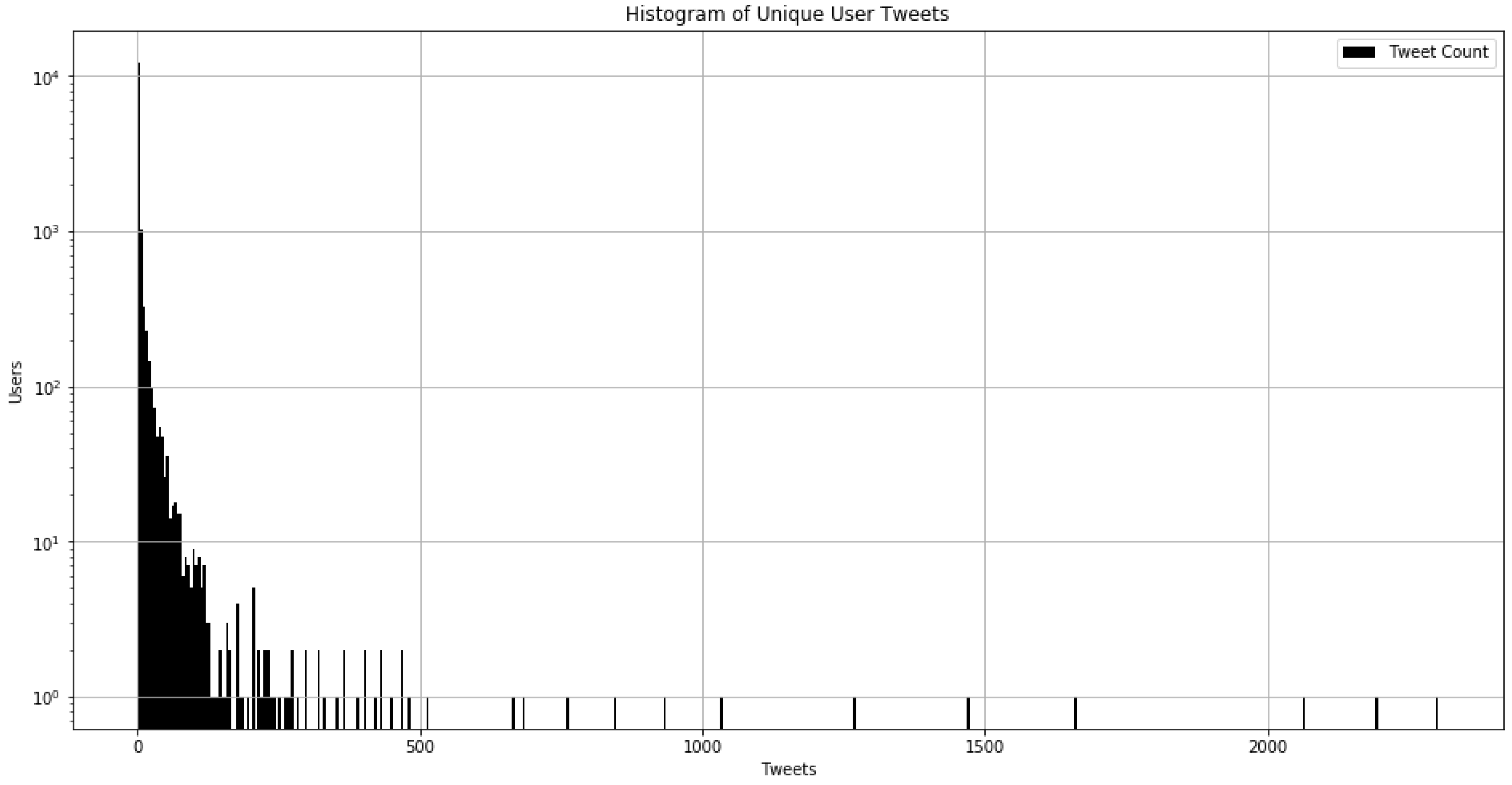
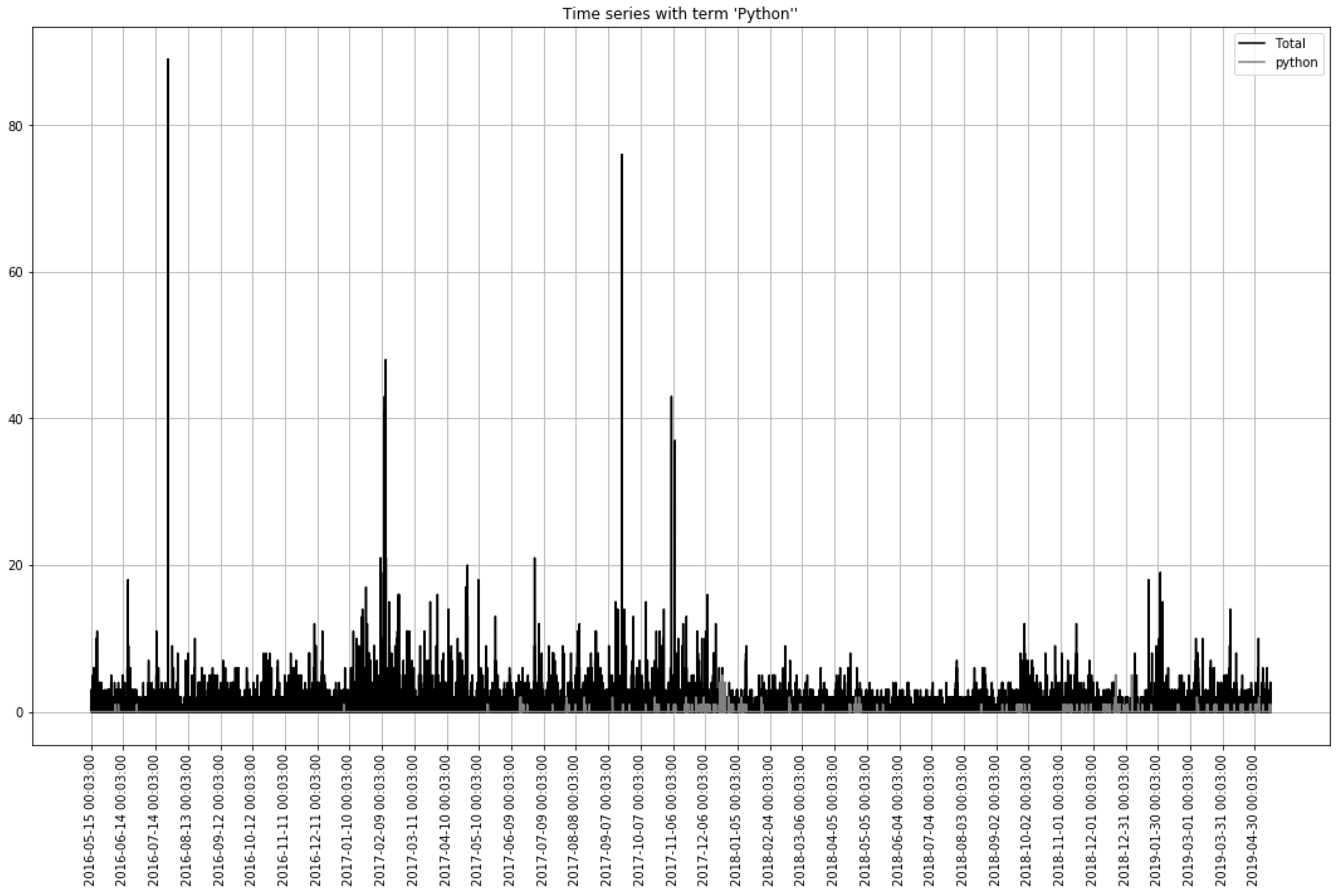
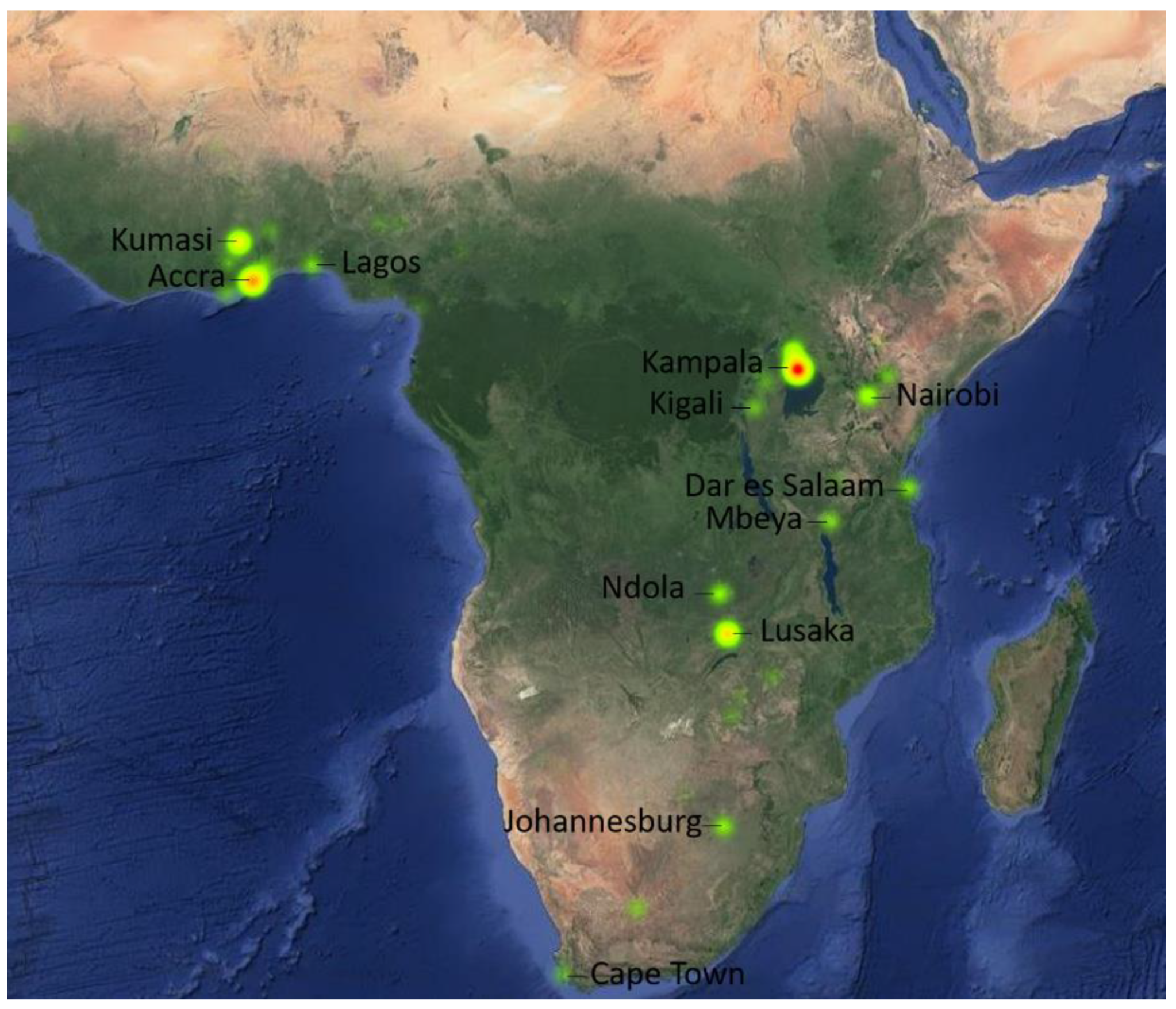
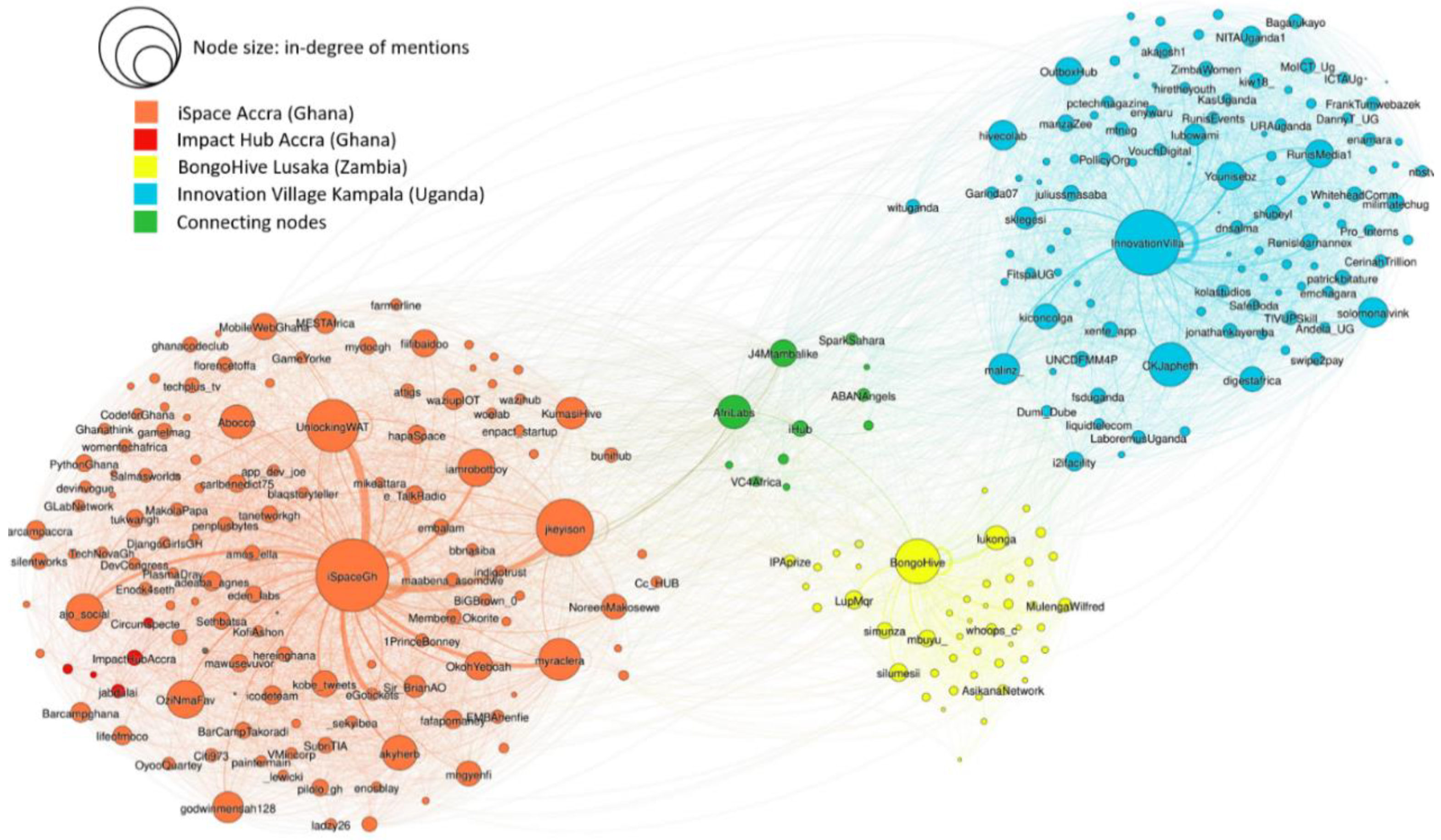
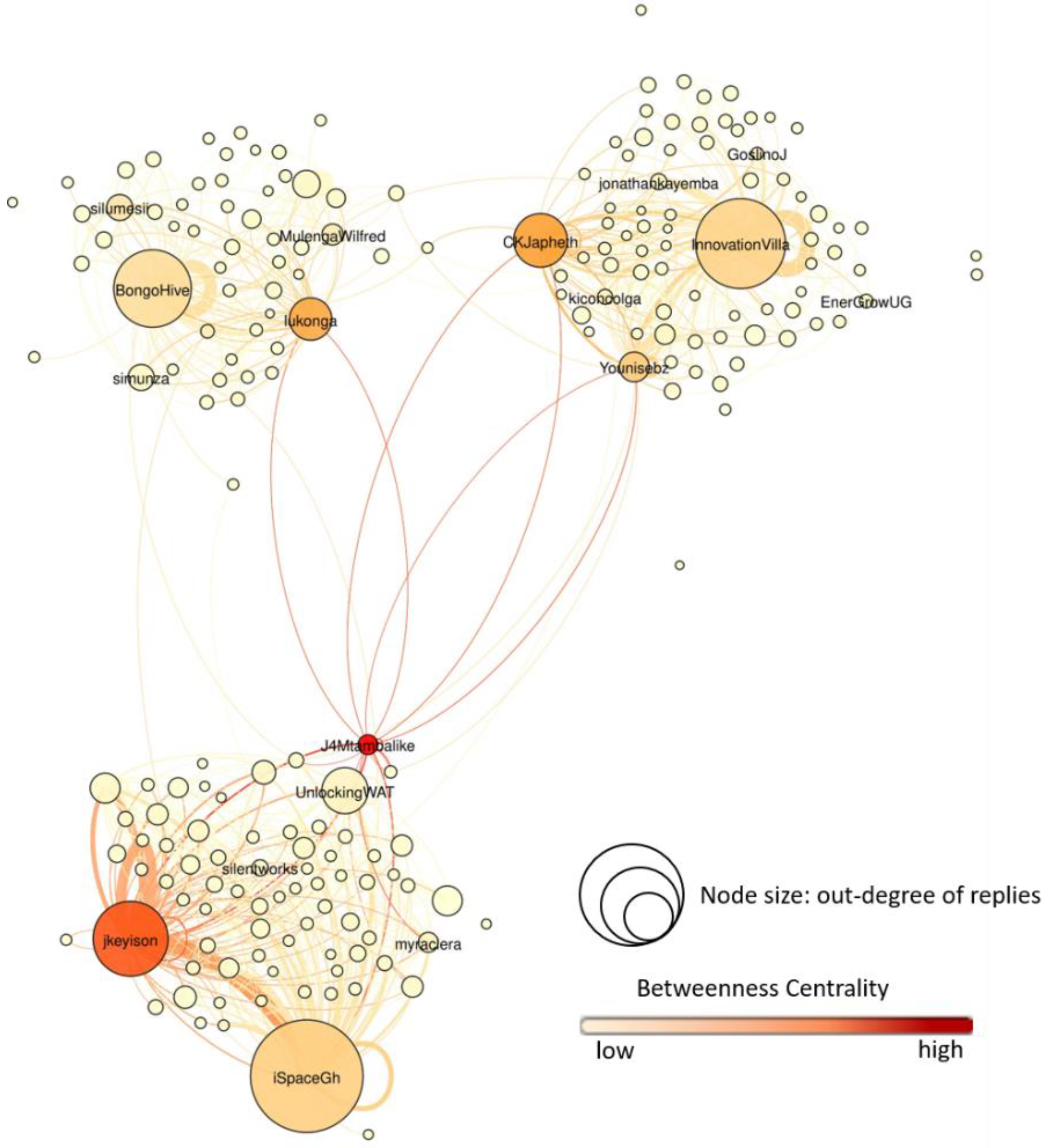
| Rank | Top Users | Tweet Count | Twitter Descriptions (Data Retrieved 23 May 2019) |
|---|---|---|---|
| 1 | UnlockingWAT | 2302 | @Google Global Diversity Award Winning Program Supported by @ComicRelief Partnered with @iSpacegh to empower #women to #innovate through #technology |
| 2 | InnovationVilla | 2193 | For #entrepreneurs and those who believe in them! #TIV |
| 3 | iSpaceGh | 2067 | An #Innovation #Hub for the Tech & #Entrepreneurial Community in #Ghana. Entrepreneurs and Startups get to Meet, Network, Work and Share ideas here. |
| 4 | jkeyison | 1660 | Co-Founder @iSpaceGH|#TechInnovator|#Marketing & #BizDev Specialist|Advocate for #WomenInTech josiah@jkeyison.co |
| 5 | eGotickets | 1472 | Africa’s fastest growing event ticketing house.  eXperience it here! Dial *713*33# or visit https://t.co/64kYgrBDAt eXperience it here! Dial *713*33# or visit https://t.co/64kYgrBDAt  Call +233 24 282 5622 #Events #People Call +233 24 282 5622 #Events #People |
| 6 | myraclera | 1271 | Fun loving, kids loving, music loving, dance loving, sadist hating, God fearing, phenomenal African Genius. Volunteering enthusiast! #Tadi is bae! |
| 7 | ajo_social | 1036 | Our aim is to connect social Problems to Social entrepreneurs and social entrepreneurs to social problems. We also connect volunteers to opportunities |
| 8 | BongoHive | 935 | Lusaka’s Technology & Innovation Hub. |
| 9 | iamrobotboy | 845 | Building your online presence, 280 xters at a time|#Netizen|I wear #Selections from @1stselections|Hubspot Inbound Marketing cert.|Tweets are my own  |
| 10 | RunisMedia1 | 761 | Building #DigitalMarketing experiences with  for great #brands|Email: runismedia@gmail.com for great #brands|Email: runismedia@gmail.com |
© 2020 by the authors. Licensee MDPI, Basel, Switzerland. This article is an open access article distributed under the terms and conditions of the Creative Commons Attribution (CC BY) license (http://creativecommons.org/licenses/by/4.0/).
Share and Cite
Schmitt, D.; Muyoya, C. Influence in Technological Innovation Spaces: A Network Science Approach to Understand Innovation for Sustainability in the Global South. Sustainability 2020, 12, 1858. https://doi.org/10.3390/su12051858
Schmitt D, Muyoya C. Influence in Technological Innovation Spaces: A Network Science Approach to Understand Innovation for Sustainability in the Global South. Sustainability. 2020; 12(5):1858. https://doi.org/10.3390/su12051858
Chicago/Turabian StyleSchmitt, Daniel, and Chisenga Muyoya. 2020. "Influence in Technological Innovation Spaces: A Network Science Approach to Understand Innovation for Sustainability in the Global South" Sustainability 12, no. 5: 1858. https://doi.org/10.3390/su12051858
APA StyleSchmitt, D., & Muyoya, C. (2020). Influence in Technological Innovation Spaces: A Network Science Approach to Understand Innovation for Sustainability in the Global South. Sustainability, 12(5), 1858. https://doi.org/10.3390/su12051858




